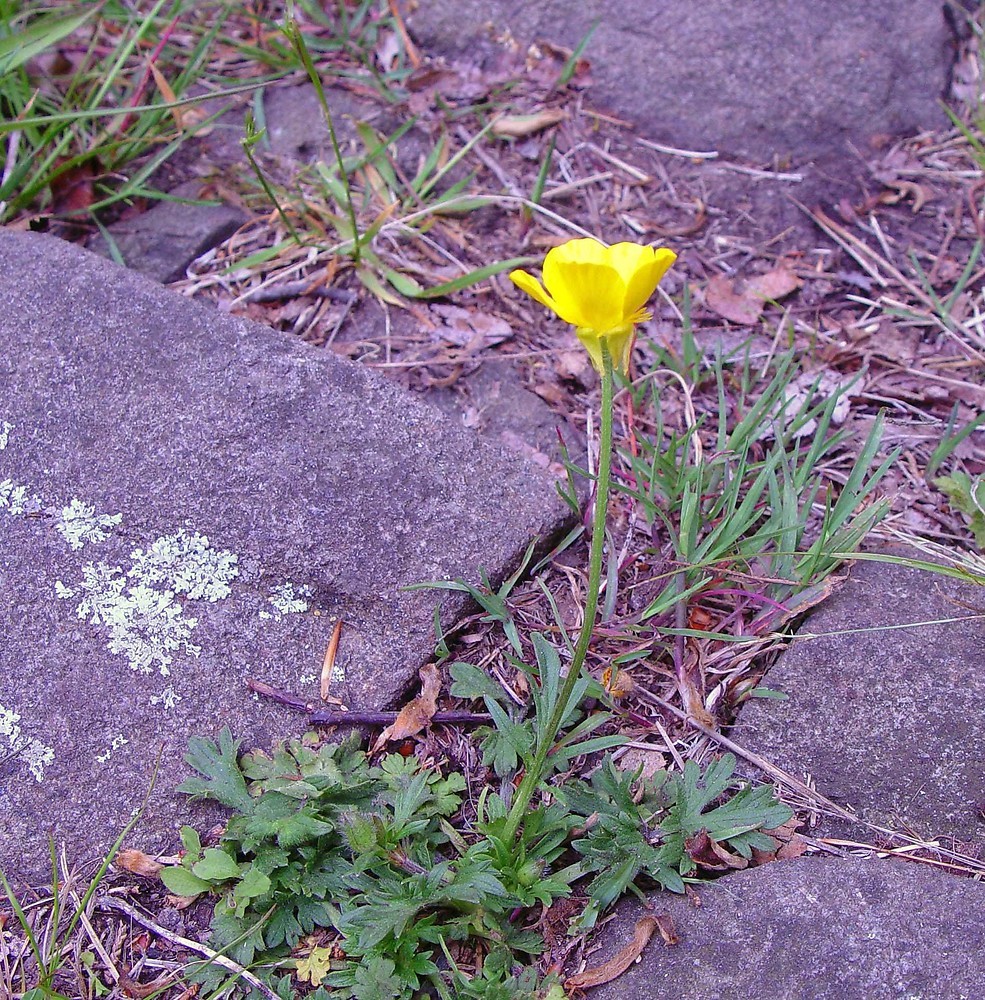Bulbous buttercup
(Ranunculus bulbosus castellanus)

Description
Ranunculus bulbosus castellanus is a type of flowering plant belonging to the Ranunculaceae family. It is a subspecies of the Ranunculus bulbosus, also known as the St. Anthony's Turnip or Bulbous Buttercup. The plant is native to the Mediterranean region, including parts of Europe, North Africa, and western Asia. In this article, we will explore the various characteristics of this plant, including its physical features, habitat, and medicinal properties. Physical Features The Ranunculus bulbosus castellanus has a height of 10-30 centimeters, and its stem is slender and hairy. The leaves are basal, deeply divided, and have a bright green color. The flowers are yellow, with five petals and a diameter of about 2 centimeters. They bloom in the spring and early summer, from April to June, and the fruit is a small, roundish capsule. Habitat The Ranunculus bulbosus castellanus is a typical plant found in dry and rocky habitats. It prefers calcareous soil and can thrive in open meadows, rocky slopes, and hillsides. This plant is mostly found in the Mediterranean region, including parts of southern Europe, North Africa, and western Asia. In Spain, the Ranunculus bulbosus castellanus is often found in the Castellón province, hence the name castellanus. Uses Ranunculus bulbosus castellanus has various uses, including medicinal and cosmetic applications. Medicinal Uses: Traditional medicine practitioners have used the flowers and roots of the plant to treat joint pain, rheumatism, and gout due to its anti-inflammatory and analgesic properties. The plant has been used to improve blood circulation, relieve arthritis symptoms, and reduce swelling and inflammation. It has also been used to treat respiratory infections, fever, and digestive disorders. It contains saponins, flavonoids, and alkaloids, which are responsible for its medicinal properties. Cosmetic Uses: The plant contains a natural dye that has been used to color textiles and cosmetics. The flowers have been used in perfumes and soaps. It is important to note that the use of Ranunculus bulbosus castellanus for medicinal purposes should only be done under the guidance of a healthcare professional. Self-medicating with any herbal remedy can have harmful effects. Cultivation Ranunculus bulbosus castellanus is a wildflower species that is not commonly cultivated. However, if you want to grow it in your garden, here are some tips: Soil: The plant prefers well-draining soil with a neutral pH level. It can grow in sandy or loamy soil, but it needs good drainage. Sunlight: The plant requires full sunlight, but it can also tolerate partial shade. Watering: The plant needs regular watering, but overwatering should be avoided. The soil should be moist, but not waterlogged. Propagation: The plant can be propagated by seed or division. The seeds can be sown directly into the ground in the fall, and the plant will flower in the following spring. The bulbs can be dug up and divided in the fall or early spring, and the new bulbs can be replanted. Maintenance: The plant is relatively low maintenance and does not require much attention. However, deadheading the spent flowers will encourage the plant to produce more blooms. Overall, Ranunculus bulbosus castellanus is a hardy plant that can grow in a variety of conditions. It can be a great addition to wildflower gardens, rock gardens, or other naturalized areas. Medicinal Properties The Ranunculus bulbosus castellanus is known for its various medicinal properties. Its flowers and roots have been used for centuries in traditional medicine to treat a range of ailments, including joint pain, rheumatism, and gout. The plant contains several bioactive compounds, including saponins, flavonoids, and alkaloids, which are responsible for its medicinal properties. The saponins in the Ranunculus bulbosus castellanus have anti-inflammatory properties, which make them effective in reducing joint pain and swelling. These compounds also help improve blood circulation and relieve symptoms of arthritis. The flavonoids in the plant act as antioxidants, which protect the body from free radical damage and reduce the risk of chronic diseases such as cancer, diabetes, and heart disease. In addition to its medicinal properties, the Ranunculus bulbosus castellanus has also been used in cosmetics. The plant contains a natural dye that has been used to color textiles and cosmetics. The flowers of the plant have also been used in perfumes and soaps. Conservation Status The conservation status of Ranunculus bulbosus castellanus is not specifically assessed. However, it is not considered as endangered or threatened species globally or regionally. Although it is a relatively common plant in the Mediterranean region, habitat destruction and fragmentation due to human activities, such as urbanization, agriculture, and grazing, may pose a threat to its populations in some areas. Therefore, it is important to ensure the conservation of its natural habitat and maintain the sustainable use of this plant. Conclusion The Ranunculus bulbosus castellanus is a fascinating plant with various medicinal properties. Its yellow flowers and deeply divided leaves make it an attractive addition to gardens, while its saponins, flavonoids, and alkaloids make it an effective treatment for joint pain and inflammation. Although it is a relatively common plant in the Mediterranean region, it is not commonly cultivated for medicinal purposes. However, its potential as a natural remedy should not be overlooked. As with any herbal remedy, it is important to consult with a healthcare professional before using the plant for medicinal purposes.
Taxonomic tree:







